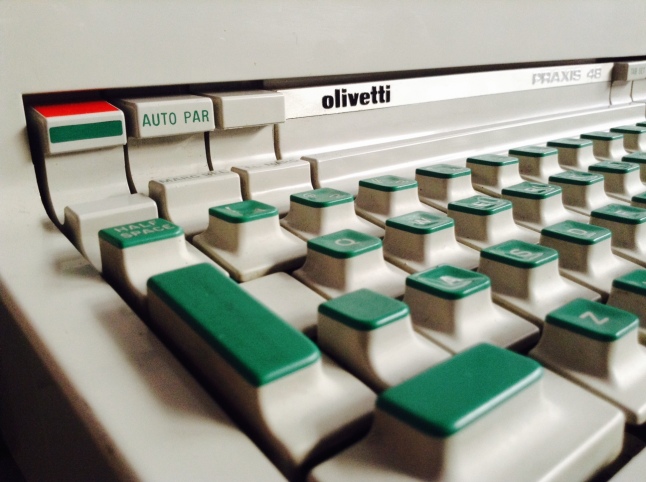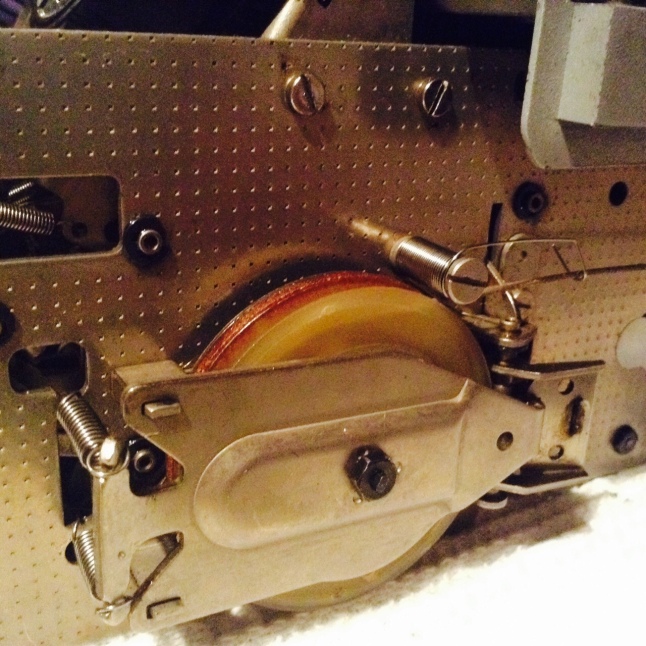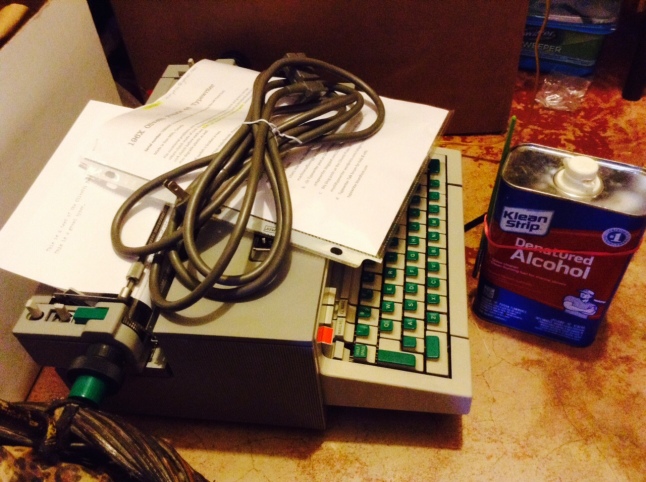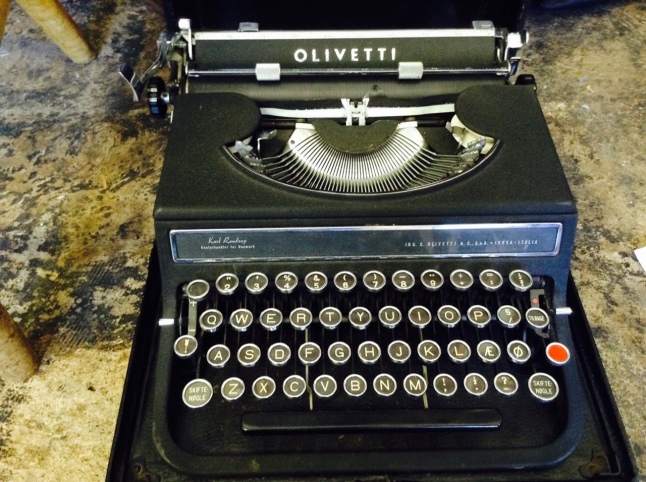We interrupt this typewriter blog post for an important public service announcement:
Olivetti Praxis
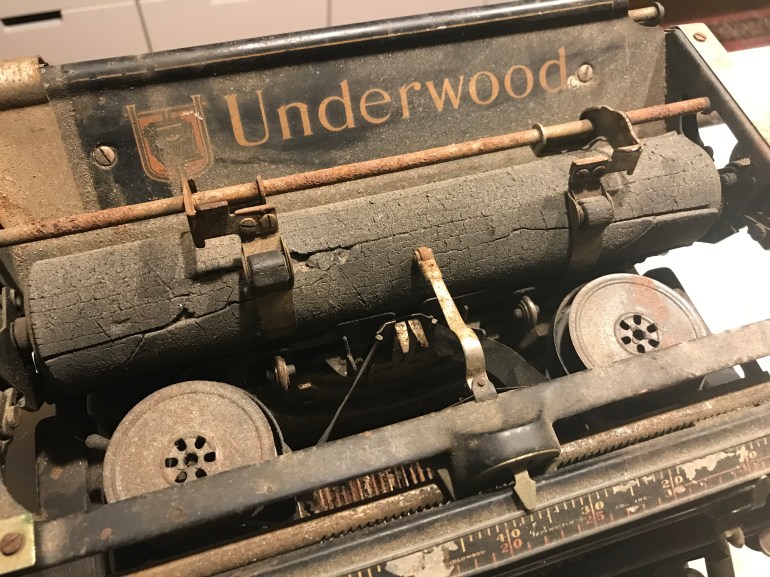

Difficult History: Olympia Robust
I have been wrassling this week with an Olivetti Praxis 48 that I have fixed once already. I bought it off of Craigslist last year, fixed it and gave it to the Arduino Kid (son of Roia who works at Mozo’s shop down the street)
I brought the Praxis home last week with its jammed carriage:
The Chewbacca mug mistook the Praxis for the Millennium Falcon and came over to see if he could recalibrate the hyperdrive motivator.
I removed some loose hinge pieces that were dangling inside, plugged it in and it worked. For a couple minutes. Then it was jammed again.
And that led to:
So I was sweating and swearing at this technological marvel when I got a phone call from Moe at Mozo’s. She got some new typewriters including a really cool Olympia that I just had to check out. So I walked over to the shop.
Lord.
On the floor, Moe? Really? With case open for stepping on?
And of course, it was One of Those.
Moe didn’t know. I pulled her over and showed her the SS key.
1943 Olympia Robust
serial number 470745
The typewriter is functional. The carriage feels a little loose and the typed imprint on the right side is a little light, but it’s typing.
The case is wooden, a faded blackish-green with a German instruction sheet pasted within it.
The typewriter has a QWERTY keyboard and German characters. My guess is that this was a US soldier’s war booty and that when he returned from overseas, he had the Y and Z placement switched.
The “front panel slide” (“schieber im Frontblech”) is mysterious. I can’t figure out what it’s supposed to do though it does obscure what has been typed. Would the slider have protected the delicate mechanics out in the field?
A lot of people have mixed feelings about these SS rune WWII typewriters. There have been lively discussions in typewriter forums about the ethics of owning an SS rune typewriter. I wish I could say something deep and meaningful about artifacts of difficult history, but I am coming up short.
I wish my father were still alive; I’d love to get his take on this typewriter. Born in 1918 at the end of the first world war, he was a US Army serviceman during the second world war. He was an expert typist and bookkeeper, skills that did not go unnoticed by his superiors, and he diligently typed and kept the books through the war. I imagine he would have studied this Olympia Robust with great interest. It is the machine of his German SS counterpart, possibly a wartime clerk like himself, who used it to type up requisition forms for canned peaches – or status reports from death camps. We don’t know.
My father had a taste for the absurd and he framed his WWII service portrait in a WWI German commemorative frame he somehow came across. It says around the frame: “Zur Erinnerung an die grosse Zeit – 1914-1915” (Memento of an Important Time, 1914-1915)
I feel my father would have regarded this typewriter as a reminder of how war is absurd and monstrous – and full of the workaday. It’s really hard to orchestrate organized, large-scale evil-doing without clerks and paper pushers. You need a good typewriter too.
We Americans like to think of ourselves as “the good guys” though we are not as morally superior as we’d like to think. US history has some very dark chapters, and that difficult history should make us a bit uncomfortable. That discomfort should prod us toward a better future.
This Olympia Robust typewriter is a piece of difficult history, an object from a dangerous time and place. I really wouldn’t want the Robust to go to someone who acquires it as a fetish – an object of dark magical power. I’m hoping that it will find a home with someone who appreciates the significance of its history in a matter-of-fact way and who will preserve it and share it as a reminder of a terrible time in the world. Cue Santayana: those who do not remember the past are condemned to repeat it.

The Arduino Kid and the Ivrea Connection
Long story short: Roia works at Moe’s antique shop where I find a lot of typewriterly inspiration. Roia is a super nice person and she’s got a couple kids. I recently fixed her daughter’s Royal Quiet De Luxe.
Anyhoo, Roia’s 17 year-old son is into Arduino electronics and 3D printing. He has a blog called Progress by Chance where he documents his projects.

photo courtesy of Progress by Chance
Roia mentioned that her son had happened upon my typewriter blog and fell in love with my Olivetti Praxis 48 (and really, who wouldn’t?). I told Roia that in the interests of encouraging the next generation of typospherians, I would happily give the Praxis 48 to her son.
Giving Roia’s Arduino-loving kid an Olivetti seemed like karmic destiny. Per the Wikipedia entry on Arduino electronics:
Arduino started in 2005 as a project for students at the Interaction Design Institute Ivrea in Ivrea, Italy… The name “Arduino” comes from a bar in Ivrea, where some of the founders of the project used to meet. The bar, in turn, has been named after Arduin of Ivrea, who was the margrave of Ivrea and king of Italy from 1002 to 1014.
Yes, that Ivrea, Italy.
The Praxis has a couple issues that might be fun for Roia’s son to tackle. One is that the plastic on/off switch is broken in two. Perhaps he could 3D print a new one?
In addition, the Olivetti’s carriage return clutch still needs work – I have to degrease it each time I use the typewriter or line spacing doesn’t work. I had ordered a thin sheet of cork and was planning to resurface the clutch, but I may end up passing that project along to Roia’s son.
Hail and Farewell, Praxis
I feel that I just got to know this Olivetti, and now it leaves me. This is good though. I know that the Praxis will go to a home when it will be loved and appreciated and perhaps inspire the next generation’s Christopher Sholes.
I sent the Praxis off to the Arduino Kid with care and feeding instructions and a can of denatured alcohol for the clutch.
Roia had another typewriter she was wondering if I could look at. It belonged to her friend Geoff and wasn’t working too well.
Oh. My.
Another native of Ivrea.

Follow the Stars, Venus and Mars
It was time to put the Olivetti Praxis 48 back together, so I returned the carriage to its shell, inserted the platen and did some testing. Everything seemed functional except that the platen did not move to the next line on carriage return. Hmmm.
Houston, We Have a Problem
Perhaps the carriage return cord needed more tension? I shortened the carriage return cord to produce a bit more *zing*. That didn’t work. In a fit of pique, I ended up dousing everything in PB B’laster.
Doing things in a fit of pique is never a good idea. My carriage stopped returning.
The cork clutch mechanism for carriage return was so slippery from excess PB B’laster that it wasn’t gripping and the carriage was not returning. The carriage return clutch is a cork-faced disk that comes in contact with a spinning metal plate. It was so oily, it couldn’t grab and my carriage couldn’t return. I could see the oil glistening, mocking me from the cork clutch.
I peeled off the carriage shell and was back at Square -1. Look at that greasy cork disc. I decided to take the return wheel off and clean the cork clutch.
The Reverend Mother always says, “When the Lord closes a door, somewhere he opens a window.” Yeah, and then the spring flies out.
The spring inside the carriage return wheel popped out as I was removing the wheel from the typewriter. It scared the heck out of me. I have had experience with Slinky Monsters before, but gosh, darn it.
After some careful swearing, I cleaned the metal carriage return plate and cork clutch with denatured alcohol and scrubbed it dry. It was squeaky clean.
I wound up the spring and secured it in its little case and reattached it to the machine.
Relief: the carriage was once again returning after the cleaning. However, the platen still didn’t space to the next line on return.
I flushed all the greasy metal parts of the return wheel mechanism and clutch with denatured alcohol, and suddenly – it was spacing properly on return. Or pretty much. I have some more degreasing to do, but it’s finally line spacing. I put the shell back on and did some typing for funzies:
Surprise, surprise: the ¼ and ½ key did not have ¼ and ½ slugs. Instead, hitting the ½ key and shift ¼ key gave me this:
Oh, funny! Oh, you Space Age Olivetti and your sex symbols. You are a delight!
I feel some heavy Space Age nostalgia when I look at my Olivetti Praxis 48. I was a little kid at the time of the the first moon landing, and I remember a retro future that still hums to me with wondrous possibility. The Praxis 48 hums: I am the future.
The Praxis 48 is the sort of typewriter you’d want to typecast from when you retire to your living module on a long-haul nuclear-powered interplanetary spaceship during the 36 lonely months en route to Saturn.
While I am ruminating on the future that is and was and ever shall be, my practical Praxis types out her thoughts on her future:

Many Happy Returns: Olivetti Praxis 48
Last weekend I brought home a nonfunctional Olivetti Praxis 48. I was able to make some progress on the machine, but I needed to get the carriage shell off to find out more about this mysterious piece of cord that was bunched up under the carriage:
This was the point where I had left off with the carriage housing still attached:
Removing the Carriage Housing from My Olivetti Praxis 48
This past week, I worked on getting the shell off the Praxis carriage. To get the housing off, I first popped the small covers on each side of the platen off with the aid of a large screwdriver as lever.
I popped out the platen by raising the retaining bars on each side.
I lifted out the metal paper pan. The blender watches with interest from the sidelines:
I removed a underside screw on either end of the carriage housing:
and popped the main housing off:
Ah-ha. The housing finally off, I saw what my problem was. The Praxis has two cords: a draw string attached to a mainspring and a carriage return string attached to a return wheel apparatus. The carriage return cord was bunching up and not winding onto its wheel because the carriage return wheel was stiff with gunk.
Once I saw what was happening under the carriage housing, I was able to straighten things out. I applied degreaser to the carriage return wheel and gently moved it with my hands until it felt looser. I depressed the carriage release button and moved the carriage back and forth until the carriage return cord began to wind smoothly onto the wheel.
I used Lectra-Motive to loosen things up. I read (after the fact) that while Lectra-Motive is a wonderful electric parts cleaner, it will eat plastic. I ran out to the garage in a panic and wiped all the internal plastic pieces down carefully. There is a surprising amount of plastic inside the machine guts of the Praxis. No harm done, but I will be more careful next time.
I was struck by how similar the electric 196X Olivetti’s problems were to the problems faced by my Foster Typewriter, the 1938 Royal KHM. Disuse and congealed gunk are the bane of typewriters no matter the vintage. The KHM came to me with a stuck carriage. Its draw string was tangled up under the carriage, and the mainspring was frozen with congealed grease. Once the draw cord was straightened out and the mainspring coaxed back into springy life with PB B’laster, the KHM’s problems receded.
The Praxis had a very similar story: a tangled cord and a stuck carriage. Once the carriage return was loosened and winding properly, the return cord behaved itself. I plugged in the machine and tested it. Wonderful. All the keys were responsive, the carriage was advancing, and the carriage returned beautifully.
Malfunctioning Tabulator Brake on My Olivetti Praxis 48
The major remaining problem was tab operation. When I hit the tab bar, the machine locked up and the carriage froze.
To release the carriage, I wiggled the plastic piece in the back and the machine resumed happy function.
I identified the round plastic piece as the tabulator brake drum. Inside the drum is a set of plastic gears.
The tab brake slows the carriage down during tabbing so that the machine doesn’t slam into tab stops.
When the tab bar on the keyboard is depressed, the top pinion gear engages with the rack:
Once the tab stop is reached, the pinion should pop up free of the rack.
My tab brake was engaging but the gears inside the drum were not turning and the top pinion wasn’t popping up once it hit the stop.
My feeling was that I had a dirt and gunk problem in the tab mechanism. I carefully applied PB B’laster to the metal tab brake parts and worked them with my hands. The gears were initially stiff, but loosened enough so the the brake gears turned and the tab mechanism moved freely. The tab mechanism finally worked as it should, braking gently with tabbing but not locking up.
I made good progress on the Praxis this past weekend. Now it is time to put the shell back on the machine. But first, lunch.
It was a pleasant afternoon so the Praxis had lunch outside with friends:

Le Déjeuner sur l’herbe AKA Neked Lunch after Manet. You’re welcome, Art History Majors.
Stay tuned for the electrifying conclusion of the Olivetti Praxis 48 story.

Electric Ladyland: The Olivetti Praxis Experience
I got it into my head that I really should bring home an electric or electronic typewriter. I suppose the hysteria of Baby Wedge Week got to me, but what really tipped me over the edge was the family blender repair.
Our Osterizer gave up the ghost a couple weeks ago after 20+ years of hard service and instead of chucking it and picking up a new blender, my husband and I decided to repair it. A coupling attached to the motor had broken in two, so we ordered a new one and installed it.
All fixed and cleaner than it has been in years :
This past week I spotted a broken Olivetti Praxis 48 electric typewriter on Craig’s List for $10. I thought, “This will be sort of like the blender, right?”
I just love the look of the Olivetti Praxis 48 – the touchable fungal key tops, the mod cantilevered keyboard, bright green accents, and the corrugated side panels – it’s all good. The only problem / great thing is that this Praxis 48 doesn’t work.
I picked up the Praxis in San Francisco. The seller was a super nice guy. He’d had it for a while, but he never was able to get the machine to turn on. He thought perhaps it had a motor problem.
I brought the machine home and took a good look at it. The serial number is located underneath the machine by the left front foot: #5060685. It appears to be a 196X Olivetti Praxis 48.
The machine was made by Olivetti Underwood Limited at Don Mills in Canada:
It’s a very cool looking 60s time machine. It takes me to days of future passed.
Oh, those wonderful, weird, squishy keys:
The guy I bought it from said that it just wouldn’t turn on. The motor switch felt strangely loose. I popped the hood and saw a broken piece of plastic:
I manually flipped the switch inside the machine and plugged her in. Hallelujah! The motor started. I will repair the plastic switch with a patch of JB-Weld epoxy. At least the motor works.
Unfortunately, the carriage wouldn’t move. It was stuck in the dead center of the machine. It moved a single space backward or forward, but that was all. The carriage release buttons wouldn’t free it.
All the keys worked and the platen rotated when I hit the carriage return button.
I removed the shell from the machine so I could clean and get a better look. I removed four screws from the bottom:
I then tried to lift off the shell. No good. I then removed a couple screws from the sliding ribbon cover that seemed to be holding the shell on:
Not yet. I loosened a couple screws under the keyboard and and slid the keyboard cover off.
It had foam padding that disintegrated into a fine dust when touched lightly:
I removed two screws in front that held the ribbon cover on and took off the ribbon cover:
I was then able to lift the machine guts out of the shell.
I plugged it in to make sure everything still worked. Even in this basic nonfunctional state, I sort of love this thing already. The motor is very quiet and the keys are so sweetly responsive. I love the *splack* *splack* *splack-splack-splack* electric typing sound.
The carriage was stuck in dead center and the carriage release buttons were not freeing it. I carefully blew out the insides of the machine. There was plenty of disintegrated foam padding debris and dust inside, but it cleaned up nicely.
Around back, I poked and prodded as I depressed the carriage release button. I jiggled the plastic piece noted below and suddenly the carriage was free:
I do not know the name of this piece, but jiggling it freed the carriage. Lucky.
I had a new problem, though, once the carriage was able to move:
This piece of cord attached to a spring seems to be part of a very elaborate draw string set up – it’s probably all tangled up under the carriage. I need to figure out how to get the carriage housing off so I can get a better look.
I feel like I made good progress today. If I can straighten out the spring + cord situation, I think I might have a completely functional Praxis 48.












